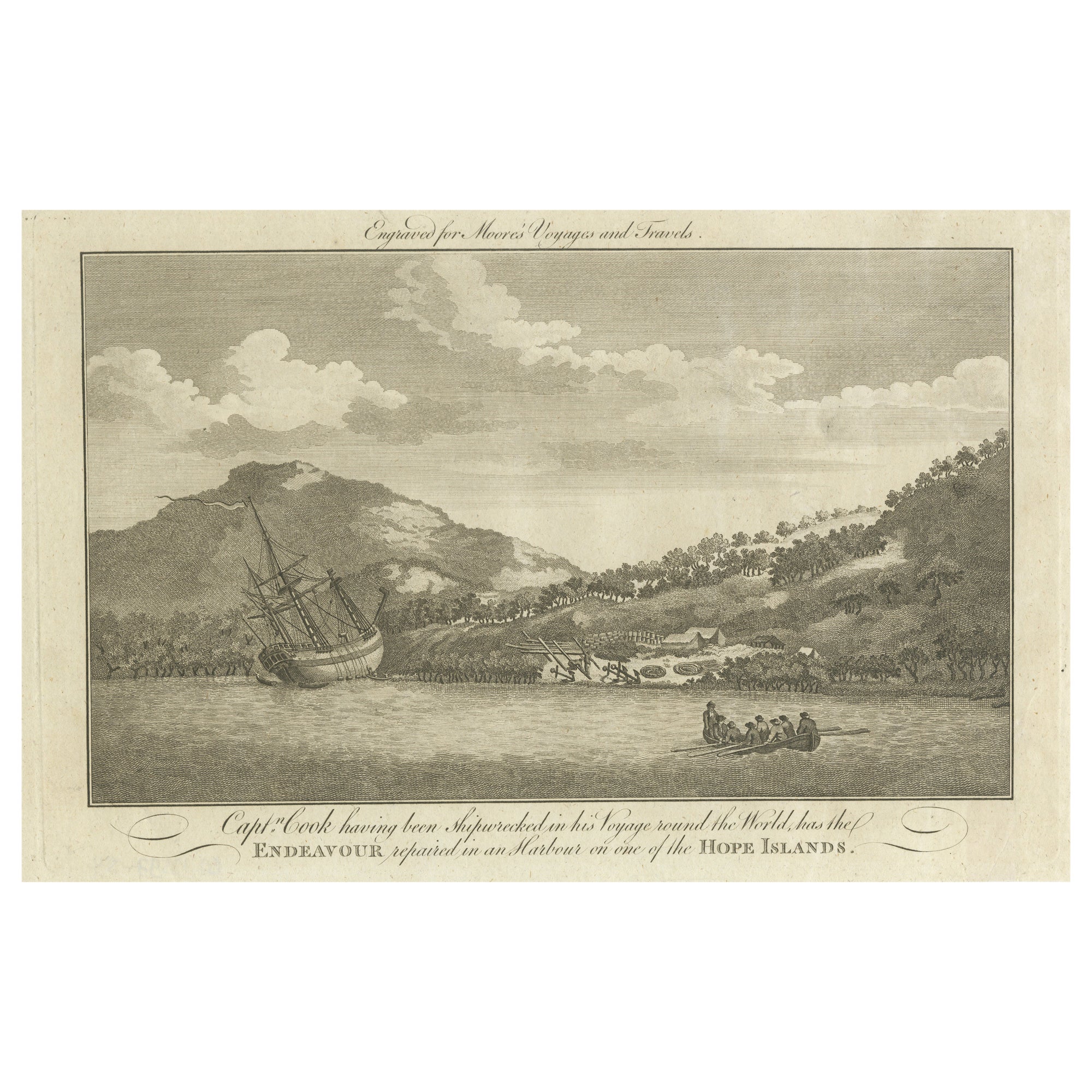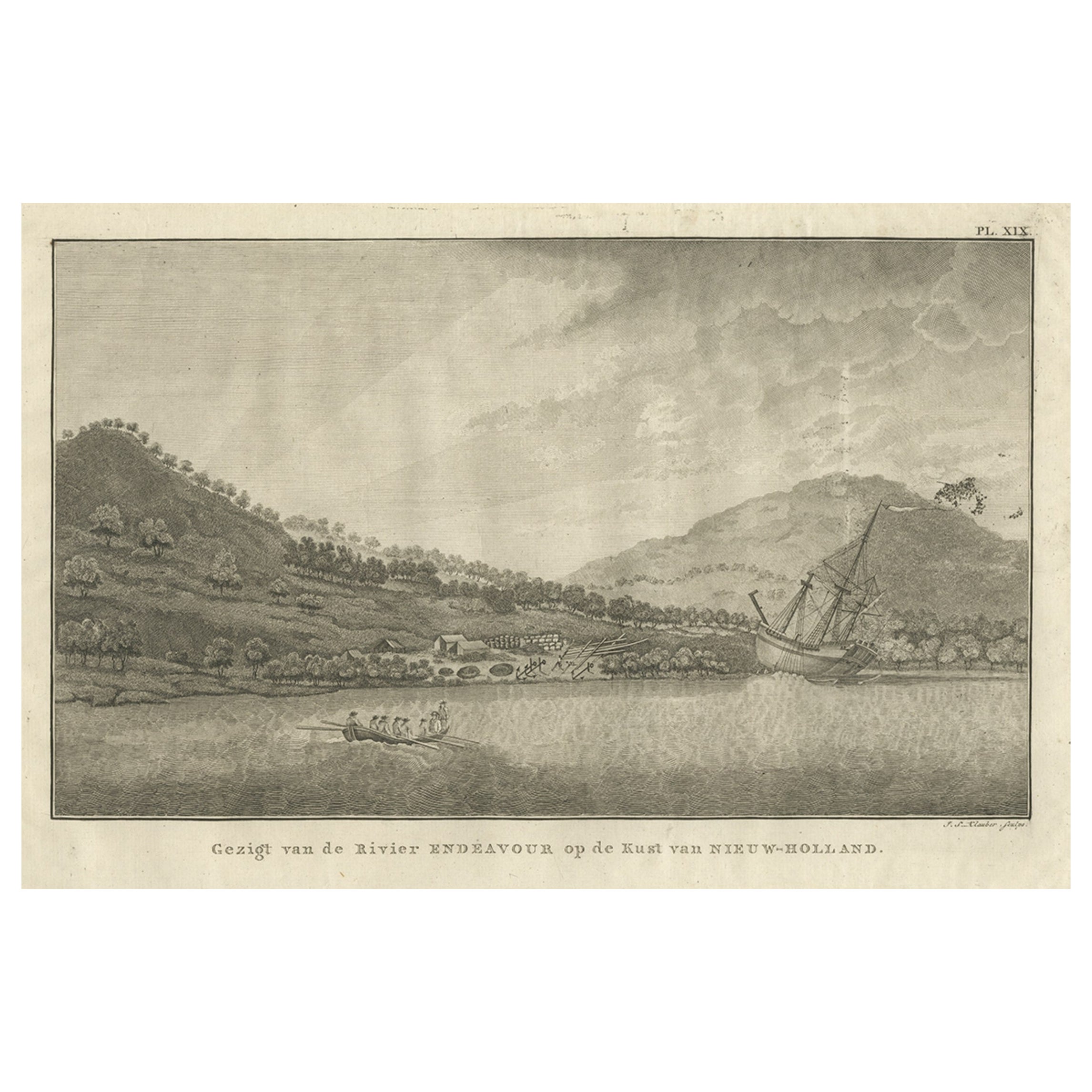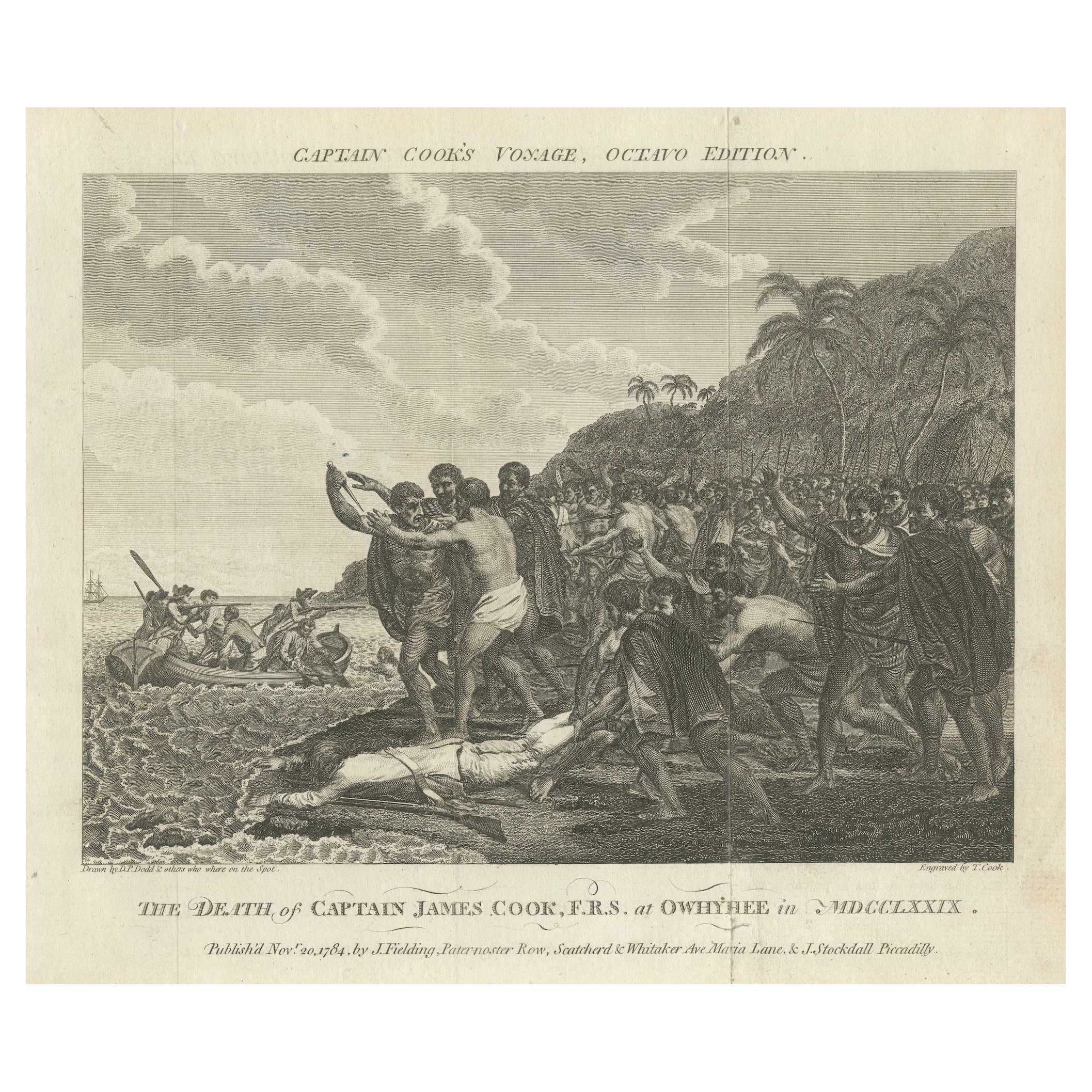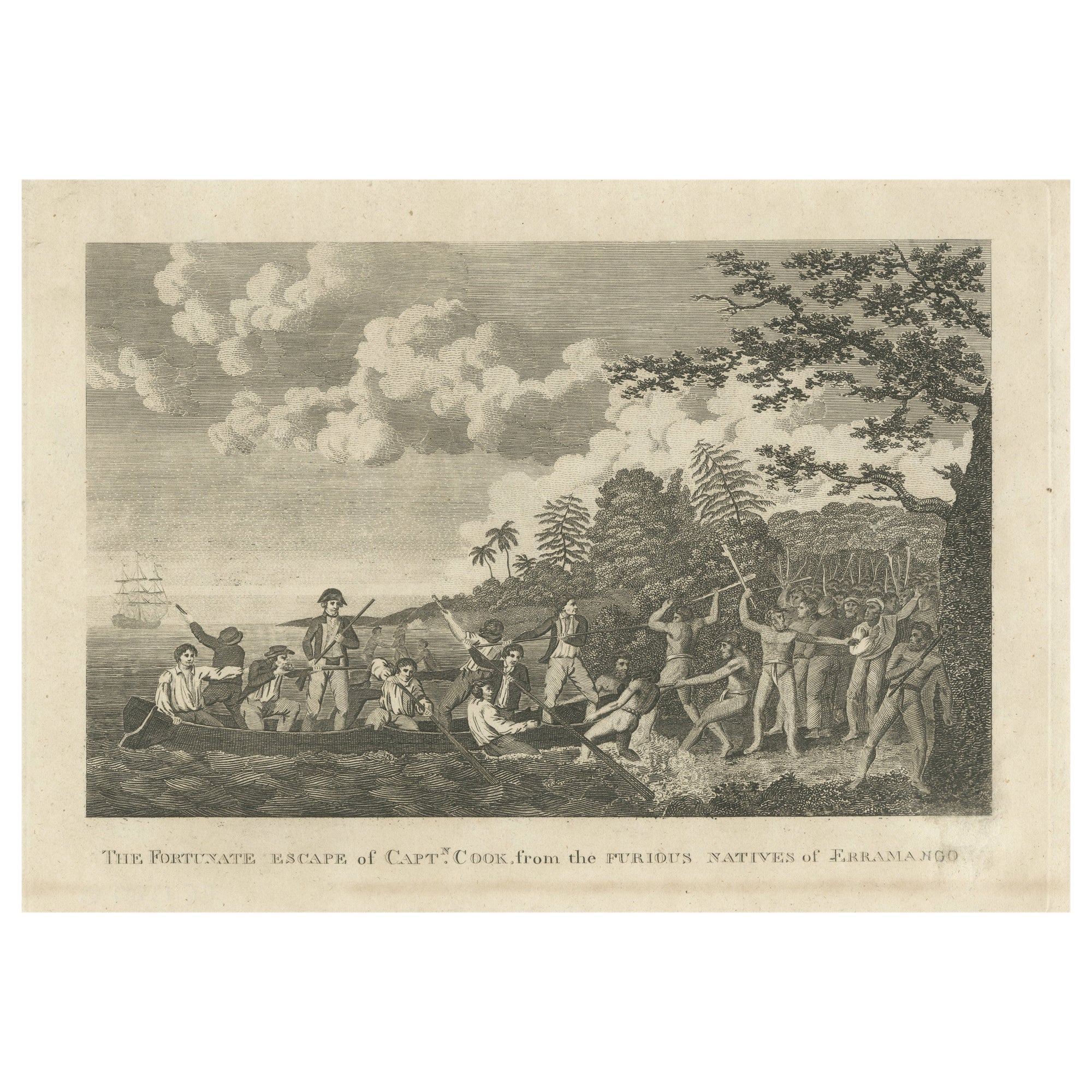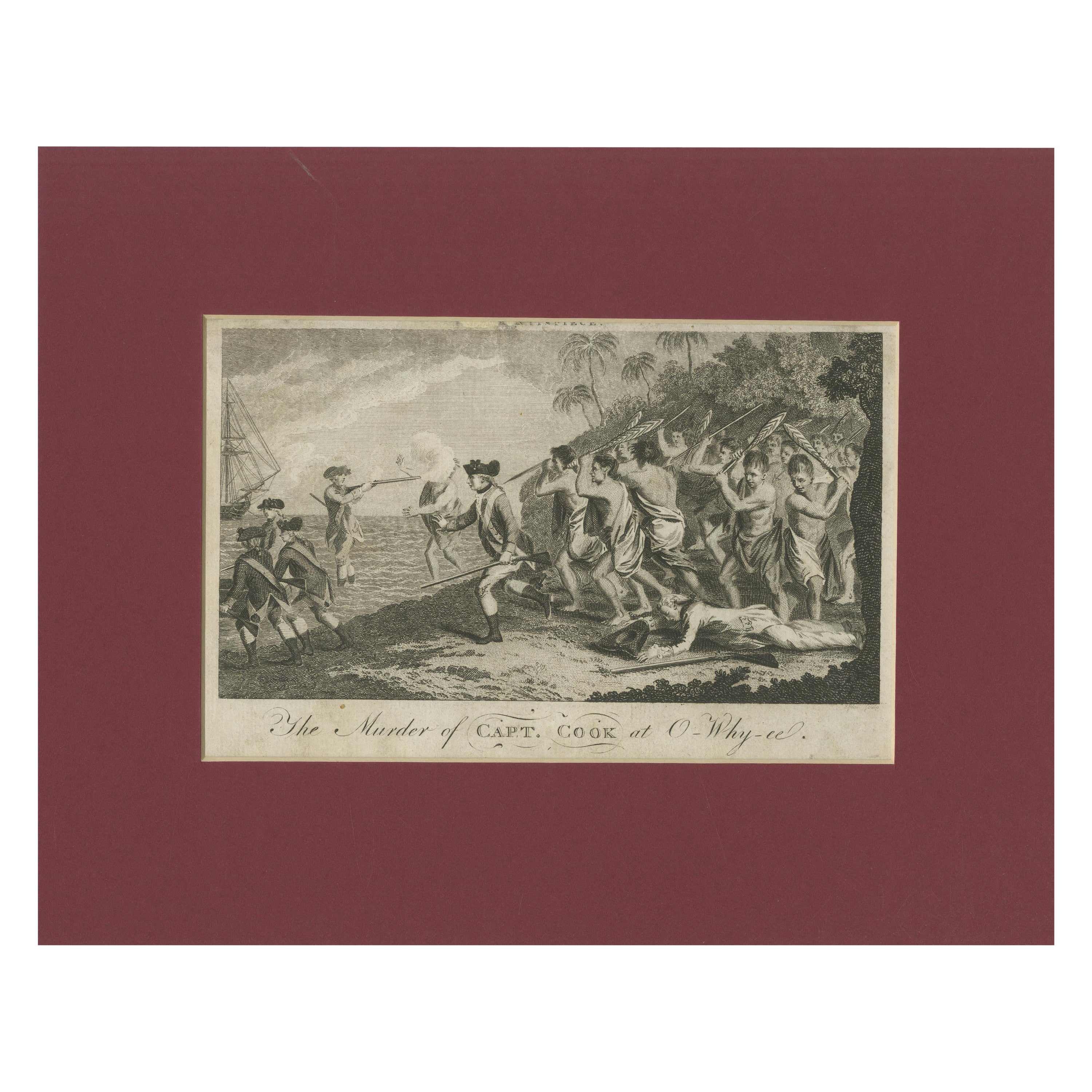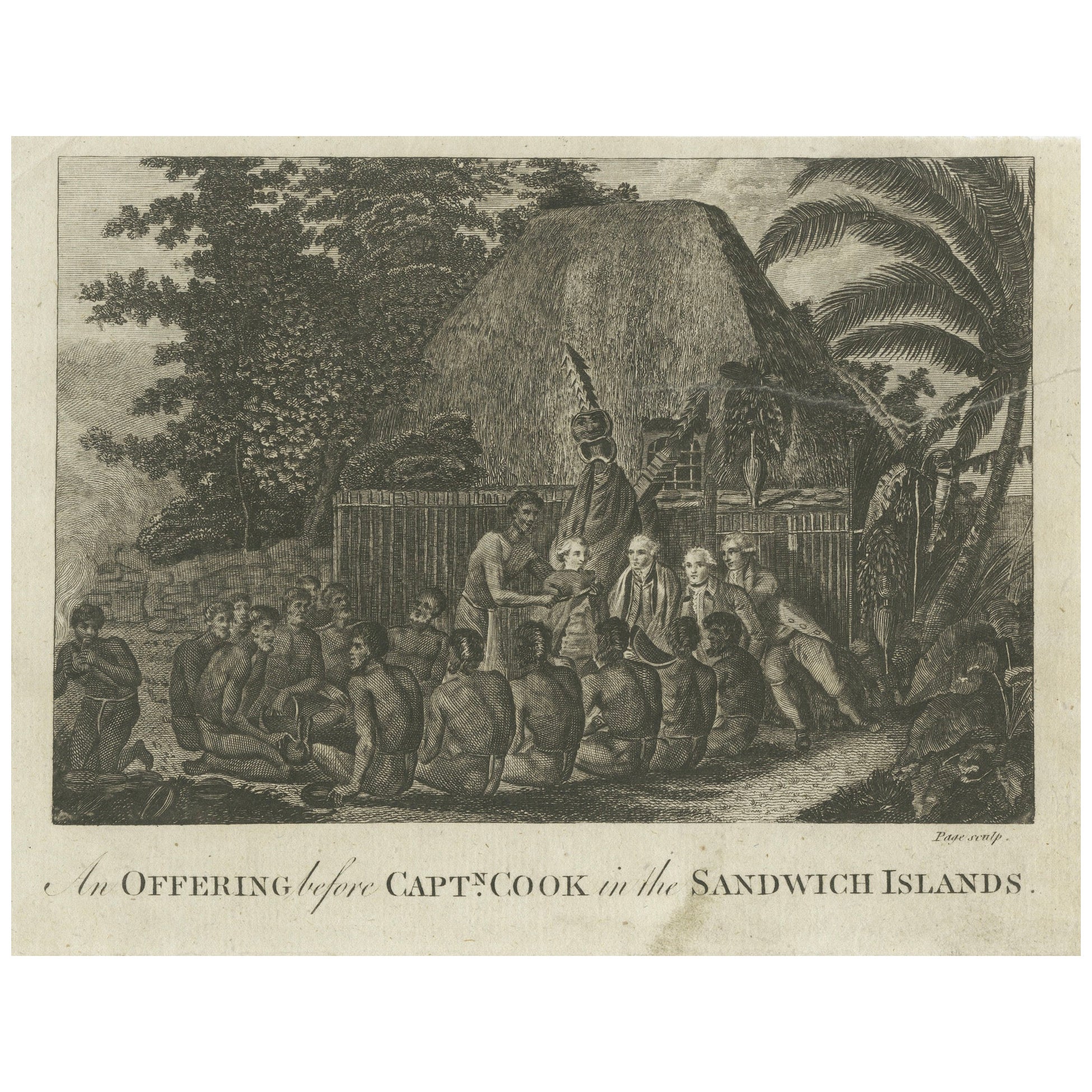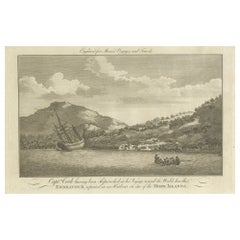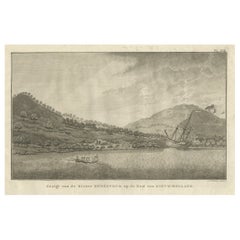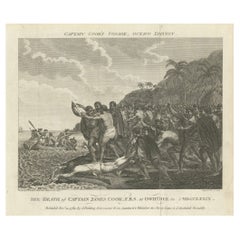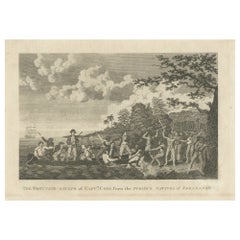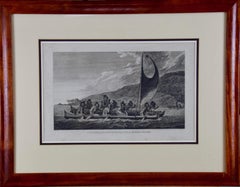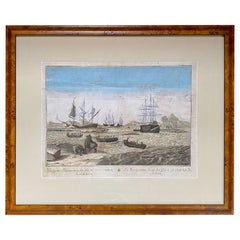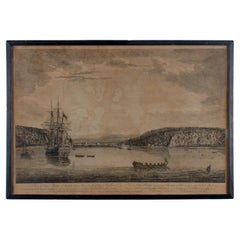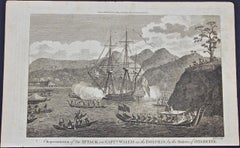Items Similar to Final Voyage: The Death of Captain Cook at Kealakekua Bay, Hawaii, 1779
Want more images or videos?
Request additional images or videos from the seller
1 of 6
Final Voyage: The Death of Captain Cook at Kealakekua Bay, Hawaii, 1779
$276.76
$345.9420% Off
£204.61
£255.7620% Off
€232
€29020% Off
CA$380.67
CA$475.8420% Off
A$423.14
A$528.9320% Off
CHF 221.80
CHF 277.2520% Off
MX$5,167.58
MX$6,459.4820% Off
NOK 2,769.07
NOK 3,461.3320% Off
SEK 2,605.18
SEK 3,256.4720% Off
DKK 1,766.21
DKK 2,207.7720% Off
About the Item
Copper engraving from Thomas Bankes’s “New System of Geography” published by Royal Authority c.1775
This engraving for sale depicts a scene of Karakakooa Bay in Owyhee (Hawaii), where Captain James Cook was killed. The image includes a number of canoes on the water and a European sailing ship, indicative of the interaction between the native Hawaiians and European explorers.
From the text within the image, it is engraved for "BANKES's New System of Geography Published by Royal Authority." The engraver's name appears to be "E. Scott, sculp." which indicates that E. Scott was the engraver (the term "sculp" is short for "sculpsit," which is Latin for "he (or she) engraved it").
The term "Owyhee" is an old spelling of "Hawaii," and this spelling was commonly used in the 18th century. Captain James Cook was killed at Kealakekua Bay on the Big Island of Hawaii in 1779, which suggests that this work was likely produced sometime after that event. However, without additional information on "BANKES's New System of Geography," it's difficult to determine the exact year this particular engraving was made.
This work likely is from:
Thomas Bankes, Edward Warren Blake, and Alexander Cook’s A New Royal Authentic and Complete System of Universal Geography (hereafter Thomas Bankes’s). A massive folio volume of 990 double-columned pages, this was a popular work, running to six editions in the years from 1775 to 1797
Thomas Bankes: 18th century collector of maps and engravings and vicar of Dixton, Monmouthshire, whose New and Authentic System of Universal Geography (London, C. Cooke, ca. 1788-90) compiled views from various countries, including some detailing the voyages of Captain James Cook.
Geographers of the seventeenth and early eighteenth centuries recognized two great divisions of their discipline. These were ‘General’ or ‘Universal’ geography, which dealt with ‘the whole Earth in general, and explain[ed] its properties without regard to particular countries’.
- Dimensions:Height: 8.86 in (22.5 cm)Width: 14.18 in (36 cm)Depth: 0 in (0.02 mm)
- Materials and Techniques:Paper,Engraved
- Period:1770-1779
- Date of Manufacture:circa 1779
- Condition:Good condition. Please study the images carefully. Minor toning or browning due to age and handling.
- Seller Location:Langweer, NL
- Reference Number:Seller: BG-13597-851stDibs: LU3054337980102
About the Seller
5.0
Recognized Seller
These prestigious sellers are industry leaders and represent the highest echelon for item quality and design.
Platinum Seller
Premium sellers with a 4.7+ rating and 24-hour response times
Established in 2009
1stDibs seller since 2017
2,604 sales on 1stDibs
Typical response time: <1 hour
- ShippingRetrieving quote...Shipping from: Langweer, Netherlands
- Return Policy
Authenticity Guarantee
In the unlikely event there’s an issue with an item’s authenticity, contact us within 1 year for a full refund. DetailsMoney-Back Guarantee
If your item is not as described, is damaged in transit, or does not arrive, contact us within 7 days for a full refund. Details24-Hour Cancellation
You have a 24-hour grace period in which to reconsider your purchase, with no questions asked.Vetted Professional Sellers
Our world-class sellers must adhere to strict standards for service and quality, maintaining the integrity of our listings.Price-Match Guarantee
If you find that a seller listed the same item for a lower price elsewhere, we’ll match it.Trusted Global Delivery
Our best-in-class carrier network provides specialized shipping options worldwide, including custom delivery.More From This Seller
View AllRepairing the Endeavour: Captain Cook's Maritime Ordeal at Hope Islands, ca.1770
Located in Langweer, NL
The engraving depicts a scene from one of Captain James Cook's voyages. The text below the image reads: "Capt'n Cook having been shipwrecked in his Voyage round the World, his ship E...
Category
Antique Late 18th Century Prints
Materials
Paper
$343 Sale Price
20% Off
Free Shipping
Captain Cook's Encampment in Australia where The Endeavour was Beached, 1803
Located in Langweer, NL
Antique print Australia titled 'Gezigt van de Rivier Endeavour op de Kust van Nieuw-Holland'.
View of an encampent on the shore of the Endeavour river on the coast of Australia where the Endeavour boat was beached. Originates from 'Reizen Rondom de Waereld door James Cook (..)'.
HMS Endeavour was a British Royal Navy research vessel that Lieutenant James Cook commanded to Australia and New Zealand on his first voyage of discovery from 1768 to 1771.
She was launched in 1764 as the collier Earl of Pembroke, with the Navy purchasing her in 1768 for a scientific mission to the Pacific Ocean and to explore the seas for the surmised Terra Australis Incognita or "unknown southern land". Commissioned as His Majesty's Bark Endeavour, she departed Plymouth in August 1768, rounded Cape Horn and reached Tahiti in time to observe the 1769 transit of Venus across the Sun. She then set sail into the largely uncharted ocean to the south, stopping at the islands of Huahine, Bora Bora, and Raiatea west of Tahiti to allow Cook to claim them for Great Britain. In September 1769, she anchored off New Zealand, becoming the first European vessel to reach the islands since Abel Tasman's Heemskerck 127 years earlier.
In April 1770, Endeavour became the first European ship to reach the east coast of Australia, with Cook going ashore at what is now known as Botany Bay. Endeavour then sailed north along the Australian coast. She narrowly avoided disaster after running aground on the Great Barrier Reef, and Cook had to throw her guns overboard to lighten her. Endeavour was beached on the Australian mainland for seven weeks to permit rudimentary repairs to her hull. Resuming her voyage, she limped into port in Batavia in October 1770, her crew sworn to secrecy about the lands that they had visited. From Batavia Endeavour continued westward, rounded the Cape of Good Hope on 13 March 1771 and reached the English port of Dover on 12 July, having been at sea for nearly three years.
The ship was largely forgotten after her Pacific voyage, spending the next three years hauling troops and cargo to and from the Falkland Islands. She was renamed in 1775 after being sold into private hands, and used to transport timber from the Baltic. Rehired as a British troop transport during the American War of Independence, she was finally scuttled in a blockade of Narragansett Bay, Rhode Island in 1778. Historical evidence indicates the ship was sunk just north of Goat Island in Newport Harbor, along with four other British transports.
Relics from Endeavour are displayed at maritime museums worldwide, including an anchor and six of her cannon. A replica of Endeavour was launched in 1994 and is berthed alongside the Australian National Maritime Museum in Sydney Harbour. The NASA Space Shuttle...
Category
Antique Early 1800s Prints
Materials
Paper
$522 Sale Price
40% Off
Engraving of The Death of Captain James Cook at Kealakekua Bay, Hawaii, 1784
Located in Langweer, NL
A historical copper engraving depicting "The Death of Captain James Cook, F.R.S. at Owhyhee in MDCCLXXIX" (1779). This engraving is particularly sig...
Category
Antique Late 18th Century Prints
Materials
Paper
$400 Sale Price
20% Off
Free Shipping
Narrow Escape: Captain Cook's Perilous Departure from Erromango, Circa 1790
Located in Langweer, NL
Title: "Narrow Escape: Captain Cook's Perilous Departure from Erromango"
Description: This original antique engraving here on offer presents a dramatic scene titled "The Fortunate E...
Category
Antique Late 18th Century Prints
Materials
Paper
$343 Sale Price
20% Off
Free Shipping
End of an Odyssey: The Fall of Captain James Cook in Hawaii in 1779
Located in Langweer, NL
This original antique print is an engraving titled "The Murder of CAPT. COOK at O-Why-e-e." This historical print depicts the moment of Captain James Cook...
Category
Antique 1780s Prints
Materials
Paper
$229 Sale Price
20% Off
Free Shipping
Ceremonial Tribute to Captain Cook in the Hawaiian Archipelago, circa 1790
Located in Langweer, NL
Title: "Ceremonial Tribute to Captain Cook in the Hawaiian Archipelago"
Description: This antique print depicts a scene titled "An Offering before Capt'n Cook in the Sandwich Island...
Category
Antique Late 18th Century English Prints
Materials
Paper
$57 Sale Price
20% Off
You May Also Like
Sandwich Islands Canoe (Hawaii): Framed 18th C. Engraving Captain Cook's Journal
By John Webber
Located in Alamo, CA
"A Canoe of the Sandwich Islands, the Rowers Masked" is an engraving created by Charles Grignion, from a drawing by John Webber (1752-1793), who was the artist on Captain James Cook's 3rd and final voyage of discovery. It is Plate 65 in the atlas of "A Voyage to the Pacific Ocean Undertaken by the Command of His Majesty, for Making Discoveries in the Northern Hemisphere", the official British Admiralty sanctioned journal published upon completion of the voyage in London in 1784 by Strahan & Cadell.
This famous image of ten Hawaiian rowers transporting a priest who is carrying a feather-covered image of Kukailimoku, the Hawaiian god of war. The priests and paddlers are all wearing gourd masks in their double-hulled canoe with an upright lateen woven sail. Each hull was shaped from a single large Koa log harvested from island rainforests, where they were carved before being transported to the coast.
This engraving is presented in a Koa wood frame and a white mat. There are occasional faint spots, but the print is otherwise in very good condition. Koa is the same wood as was used to make the canoe. Koa wood is legendary in Hawaii. Not only is this amazing wood native to Hawaii, but it is known for the deep rich colors and varied grain pattern. Koa has an honored heritage in Hawaii and is highly revered and sacred. The word “koa” means “warrior” in Hawaiian. The warriors of King Kamehameha the Great, created canoes and weapons from a wood plentiful on the Big Island of Hawaii. This wood became synonymous with the warriors themselves, and it became known as koa. The frame measures 20.75" high, 26.75" wide and 0.88" deep.
There are three other engravings listed from the official journal of Captain Cook's 3rd voyage available that are presented in identical Koa wood frames and mat (LU117324682022, LU117324684052, LU117324684062). They would make a wonderful grouping for a display of 2, 3 or 4 prints. A discount is available for a grouping depending on the number of items included.
Hawaii was discovered by Captain Cook (1728-1779) during this voyage. Hawaii was originally called The Sandwich Islands in honor of The Earl of Sandwich...
Category
1780s Landscape Prints
Materials
Engraving
Early 18th Century Engraving of the Northern Whale Fishery, circa 1720
Located in Nantucket, MA
Very early 18th century Dutch woodblock engraving of the Northern Whale Fishery, circa 1720, a hand colored engraving illustrating the Dutch whaling flee...
Category
Antique 1720s Dutch Baroque Prints
Materials
Paper
A View of Cape Rouge, Quebec, Canada, Mazell after Capt. Hervey Smyth, c.1760s
Located in Savannah, GA
A View of Cape Rouge, or Carouge, on the Saint Lawrence River, north of Quebec.
Engraving by Peter Mazell after a drawing by Captian Hervey Smyth, published c.1760's, London.
T...
Category
Antique 1760s Canadian British Colonial Prints
Materials
Paper
Attack on Captain Wallis When He Discovered Tahiti: Original 18th C. Engraving
Located in Alamo, CA
"A Representation of the Attack on Captain Wallis in the Dolphin by the Natives of Otaheite (Tahiti)" is an engraving created by the artist Sparrow based on an engraving in John Hawk...
Category
1780s Landscape Prints
Materials
Engraving
A Human Sacrifice, in a Morai, in Otaheite (Tahiti) 1784 James Cook Final Voyage
By John Webber
Located in Paonia, CO
A Human Sacrifice in a Morai in Otaheite (Tahiti) 1784 by John Webber is from the First Edition Atlas Accompanying Capt. James Cook and King; Third and Final Voyage of Captain...
Category
1780s Realist Figurative Prints
Materials
Engraving
Flotte d'Otahiti Assembled at Oparee, Colored Engraving, Robert Benard, 1778
By Robert Benard
Located in Madrid, ES
Flotte d'Otahiti assembled at Oparee. Colored engraving. Robert Benard (active 1750-1785), 1778.
Hand-colored engraving from the series “The Voyages of Captain Cook”, which makes n...
Category
Antique 1770s European Neoclassical Prints
Materials
Other
